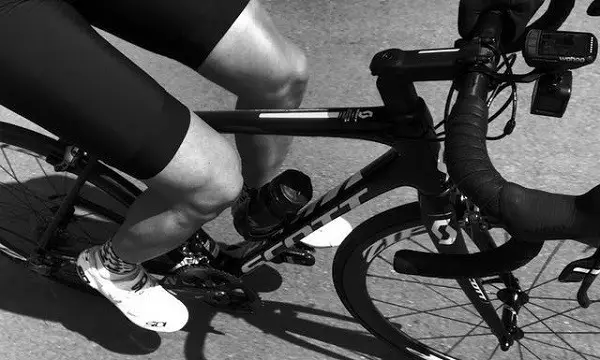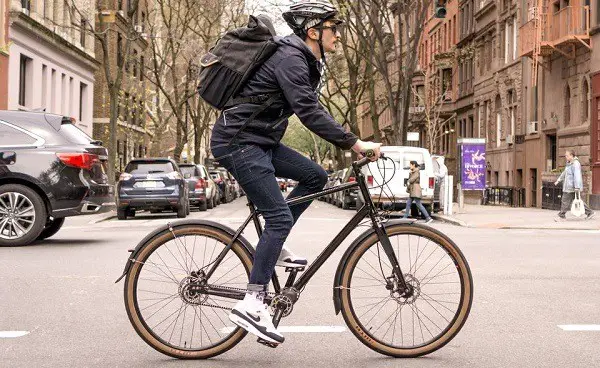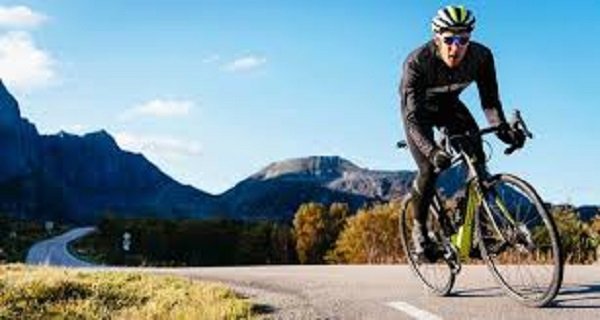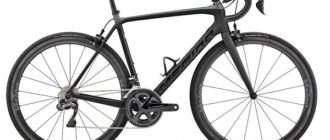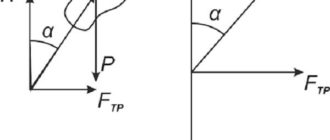Every cyclist has thought at least once about the speed at which he or she travels by bicycle. It is clear that a rider on a two-wheeler goes faster than a pedestrian, but slower than a car. So what is the average speed of a cyclist? Today we will try to give a comprehensive answer to this question. We will tell you how much speed a bicycle can reach on the highway, highway, city, country road and other areas. And also designate the main points that can affect the speed of the rider.
Speed records on a bicycle
Many novice cyclists naively believe that they move at almost the same speed as a car in the city – about 25-30 km / h. But the numbers on the speedometer do not always correspond to reality. In fact, only professional sportsmen manage to keep a high average speed.
As a source of inspiration, we suggest paying attention to the speed records among cyclists:
- Maximum velodrome speed. Let’s note at once, the record cannot be considered full-fledged, and you will soon understand why. 51,151 km/h – this is the speed achieved by the sportsman from Italy. In 1984, Francesco Moser rode 51 kilometers and 151 meters in 60 minutes. The cyclist admitted that special substances helped him to maintain such speed – at that time sportsmen were not forbidden to use stimulants.
- Maximum speed in a straight line. The world record was set by the Dutch athlete, 26-year-old Sebastian Bowyer in 2013. To achieve the outstanding result, the rider installed an aerodynamic fairing on his bike. By the way, the unit to achieve the record was really unusual: the cyclist rode lying on his back, the pedals of the bike was located in front, and directly all transport was surrounded by an ultralight fairing made of carbon fiber. The model was designed by students of the Free University of Amsterdam and Delft University of Technology. Oh, and speaking of birds: the Dutch athlete managed to reach 133.78 km/h in a straight line.
- The maximum speed in a straight line. Another record belongs to Fred Rompelberg from the Netherlands. This time the maximum speed in a straight line was achieved by covering the bike with an air bag. The 50-year-old athlete was able to reach an incredible speed of 268.83 km/h. The absolute record was set on the dry surface of a salt lake in Utah. The bike followed a racing car, the spacious fairing of which protected the cyclist from the air currents. Of course, the record was also achieved by a specially designed bike, which is not adapted for normal roads.
Recently, an athlete from the United States was able to break the record set by Fred Rompelberg. In 2019, Denise Muller-Korenek accelerated her bike to 295.6 km/h! The racer rode a carbon fiber bike whose construction allows her to accelerate to cosmic speeds.
- Maximum speed when going down the mountain. The speed record (222 km/h) was achieved on a mountain bike by the French athlete Eric Baron in 2000. The events unfolded on a run-in ski track in the French Alps. To achieve the record, a machine with improved aerodynamics was designed. The bike came complete with a shock-absorbing fork and rear suspension. The rider himself was equipped in an aerodynamic suit.
- The maximum average speed on a road bike. The record – 41.654 km/h – belongs to road racer Lance Armstrong from the United States. The athlete set it at the race “Tour de France” in 2005.
As you can see, there is a lot to strive for. Of course, the average cyclist cannot achieve such speed. Even the powertrain installation will not allow to accelerate to such values. So what can ordinary amateur cyclists count on? What is their average speed?
The capabilities of the untrained cyclist
The records presented above can inspire even a person who has nothing to do with cycling. What to say about the guys who can’t imagine a day in their life without a two-wheeled friend? So what is the average speed of an untrained cyclist on ordinary roads?
The device for measuring the speed of a bicycle was invented relatively recently. Just 20-25 years ago bikes were installed on heavy speedometers, which gave the result with large errors. Today’s cyclists have access to compact and accurate bicycle computers that provide not only information about the average speed of the bike, but also data about the distance traveled and time spent on the road, etc.
What can an average cyclist who is not training to compete rely on? As practice shows, the average rider on a mountain bike within its capabilities can keep the speed of 18-20 km / h on the highway, thus, passing 10 km for half an hour. On smooth asphalt with the same conditions, the cyclist can move at a speed of 20-25 km / h, passing the same distance in 25 minutes.
This is important! The average cyclist can be called a person who rides about 20-50 hours per month.
At short distances to develop a speed of about 17 km / h can almost every cyclist. But a more experienced rider, riding more than a thousand kilometers a year, will pass this distance in half the time. No matter how you look at it, but regular training develops the musculature and respiratory system, increases the body’s endurance and, accordingly, leads to a noticeable result. Experienced cyclists easily maintain an average speed of about 30 km / h for a distance of 100 km on the highway.
Of course, a speed of 30 km/h is possible under certain conditions. At a minimum, the physical fitness of the cyclist and a suitable trail. And what about riding on the stone jungle? In the city, the rider stops at intersections, brakes before obstacles and turns, passes pedestrians, detours cars, etc. Therefore, the average speed of a cyclist in the city is only 10 km/h.
Despite the fact that the road bike allows you to develop a much higher speed than the mountain bike, it is not recommended to ride it in the city. Low landing, poor visibility, and to make an emergency stop on such a bike is not possible.
As you have already realized, the speed depends to some extent on the type of bike. There are other factors that have a direct impact on the acceleration of the cyclist.
What affects cycling speed
It doesn’t matter the gender of the cyclist. Age doesn’t matter either – there are some very nimble grandparents who will give any teenager a head start. But there are factors that directly affect the cyclist’s speed. Let’s consider the main ones:
- Level of fitness. No matter how you spin it, but a person who regularly rides a bicycle is able to develop a much higher speed and hold it for a certain amount of time. The rider’s experience matters more than the type of bike he or she rides. On the highway, a more experienced rider will be able to leave novice riders behind.
- Cadence. The speed of the pedals per minute should always remain between 60 and 90 revolutions. It is not necessary to twist the pedals jerkily, periodically letting the bike move by inertia. In this case, you have to overcome the cadence threshold, due to which the speed is reduced.
- Headwinds. The position of the rider on the bike cannot be considered aerodynamic. The flow of counter air significantly impedes the speed gain. Especially it is felt at 25-27 km/h. If a headwind blows, it becomes much more difficult to move already at 5-10 km/h. It is harder to pedal on a mountain bike with a wide and high set handlebar than on a road bike. The latter, by the way, has a feature – a steering wheel type “ram’s horns. When a strong flow of oncoming air, the rider can bend the body to the handlebars, thereby significantly reducing the resistance to air. It is possible to significantly minimize the pressure of the oncoming airflow by getting into an air bag. For instance, you may ride after the bus or a lorry ahead of you, but it is very dangerous.
- Rolling resistance. This factor becomes especially appreciable in the beginning of movement. More energy is spent on acceleration from a place. As you gain speed, the rolling resistance starts to decrease.
- The width of the tire. This factor is derived from the previous one. Increased friction between the tire and the road surface increases rolling resistance. A narrow tire that has squeezed through soft ground is harder to get off the ground. A tire with a wide tread rubs against the asphalt and wears out faster. Therefore, you should choose tires taking into account what kind of roads you drive on most often.
- Travel time. Of course, the longer the trip, the lower the cyclist’s speed will be. This is due to general body fatigue.
This is important! The pressure level of the tubes is also important. You also need to know how to inflate the wheels. The more inflated the tube, the easier the wheel rolls on asphalt and other hard pavement. And in order to more easily overcome loose soil, it is recommended to deflate the air.
- Friction in gears. With a high degree of probability to reduce the speed of the cyclist can strongly contaminated chain, worn hub and carriage. Too soft shock absorbers also do not allow much acceleration on smooth pavement.
About the weight of the cyclist and the bike itself does not need to say much. It is clear that a heavy object is more difficult to accelerate.
The age of the cyclist
And here we should pay a little more attention to this point. Age is just a number in the passport. Definitely say that the cyclist of a venerable age can not overtake a young rival, it is impossible. History knows quite a few cases when quick old men were giving a head start to the young generation:
- Swedish farmer Gustav Håkansson at the age of 67 took part in a large-scale bicycle race. The man covered 600 km and finished first.
- Robert Marchand from France is a truly unique man. So, in 2017, he rode without a single stop for 20 km. It would seem that there is not much of a surprise in this – you can ride a bicycle much more in a day. However, the Frenchman at that time was 105 years old!
- A pensioner from Great Britain, 88 years old, rode a bicycle all over the country. Lawrence Brophy covered a distance of nearly 1,500 kilometers in 25 days.
As you can see, age does not matter to the cyclist. If you maintain a healthy lifestyle, train regularly and have a reliable iron friend under you, you can easily maintain an average speed, leaving behind young riders.
Average Speed in Different Locations
Of course, the average speed of an amateur cyclist on the trail will be quite different from riding on rough terrain. Nor should you equate speed in a city with speed when riding down a mountain on a bicycle. However, it is possible to allocate some average indicators:
- 18-20 km/h on the highway;
- when going downhill – 25 km/h;
- on loose ground (sand, fallen leaves, snow, etc.) – is 5-8 km / h;
- the average speed of the cyclist in the city is 10-15 km/h;
- on a rough terrain – is equal from 5 to 15 km/h.
The type of bike is also important. Agree, on a city bike is difficult to develop a decent speed, even on perfectly smooth asphalt in windless weather.
At what speed it is possible to travel by bicycle
If you go back to the beginning of the article and look again at the records of some cyclists, you can understand that nothing is impossible. With good physical fitness and a certain bike upgrade you can achieve impressive results. Strive for this is not necessarily, but to improve their speed performance is possible. The main thing is to keep a comfortable speed for yourself and the bike.
As an example, let’s take a road with mixed terrain and mark the average speed figures:
- A novice amateur cyclist for a short distance will be able to hold at about 20 km/h for a short time.
- More experienced riders will be able to ride at about 25 km/h.
- Athletes regularly participating in competitions will show a much more solid result – about 30 km/h.
- A systematically trained person will be able to ride for a long time at a speed of 33 to 35 km / h.
Much depends on the overall fitness level and type of bike. It also depends on the quality of attachments and the bike itself. To date, the optimal speed for the cyclist is 15-20 km / h. If you confidently hold on to the 10 km / h – it is a good indicator.
Which bikes are faster?
The average and maximum speeds depend on the transport, and more precisely, on the category of bike. It is clear that not all units allow you to develop a decent speed, even on a flat track. It matters the type of equipment, wheel diameter and tire width, transmission performance and other factors. Consider the main types of bicycles in the context of how much speed you can develop on them:
- Road bikes. Large, fairly heavy bikes are designed for driving on the highway or highway with a quality surface. It is not possible to develop a high speed on them. Their ceiling is 15 km/h.
- City bikes. Walking bikes are characterized by low weight, functional construction and elegant design. This category of bikes allows you to move with a “cruising” speed in the city – about 10 km / h.
- Highway bikes. And here these “swallows” allow a decent speed up to 25, and even 30 km / h.
- Mountain bikes. If you go on a mountain bike on the highway, you can speed up your steed up to 25 km / h.
Not bad rates demonstrate and hybrid models. So, they can move at a speed of 25 to 28 km / h on smooth pavement.
How to measure speed
Modern cyclists use special speedometers or bicycle computers to measure speed. Today’s gadgets can also show pedal speed, distance traveled and total travel time, heart rate, incline, and other information.
Primitive speedometers for bicycles have in their design special sensors that are attached to the wheel. This way of measuring does not allow you to get the most accurate information. Therefore, some cyclists prefer to use bicycle computers – these gadgets show the speed, focusing on GPS data. By the way, a bicycle computer also allows you to create a route map and record the time – all you have to do is calculate the average speed yourself, using a well-known formula.
Recommendations for speeding up
If your immediate plans are to beat the world speed record on a bike then you need to properly upgrade your bike and put all your time into intensive training and studying the laws of aerodynamics. If your plans are more basic and you just want to go a little faster than usual, here are some tips to help you increase your average bike speed:
- buy a special outfit (tight clothing will reduce your resistance to oncoming wind currents);
- Put contact pedalson your bike;
- If you ride a MTB, put a tire without aggressive tread;
- Learn to take an aerodynamic position on the bike (in this plan helps “ram’s horns” or a bicycle bed);
- keep the drivetrain clean and in good working order;
- properly inflate the air in the wheels.
Increase your cruising speed can be done in other ways. For example, lighten the bike.
Conclusion
In conclusion, we can add: the main goal of the cyclist – to enjoy the process of riding. So stick to your comfort level and enjoy the perfect and well-coordinated work of all mechanisms.


